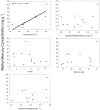Experimental and natural warming elevates mercury concentrations in estuarine fish
- PMID: 23554891
- PMCID: PMC3595298
- DOI: 10.1371/journal.pone.0058401
Experimental and natural warming elevates mercury concentrations in estuarine fish
Abstract
Marine food webs are the most important link between the global contaminant, methylmercury (MeHg), and human exposure through consumption of seafood. Warming temperatures may increase human exposure to MeHg, a potent neurotoxin, by increasing MeHg production as well as bioaccumulation and trophic transfer through marine food webs. Studies of the effects of temperature on MeHg bioaccumulation are rare and no study has specifically related temperature to MeHg fate by linking laboratory experiments with natural field manipulations in coastal ecosystems. We performed laboratory and field experiments on MeHg accumulation under varying temperature regimes using the killifish, Fundulus heteroclitus. Temperature treatments were established in salt pools on a coastal salt marsh using a natural temperature gradient where killifish fed on natural food sources. Temperatures were manipulated across a wider range in laboratory experiments with killifish exposed to MeHg enriched food. In both laboratory microcosms and field mesocosms, MeHg concentrations in killifish significantly increased at elevated temperatures. Moreover, in field experiments, other ancillary variables (salinity, MeHg in sediment, etc.) did not relate to MeHg bioaccumulation. Modeling of laboratory experimental results suggested increases in metabolic rate as a driving factor. The elevated temperatures we tested are consistent with predicted trends in climate warming, and indicate that in the absence of confounding factors, warmer sea surface temperatures could result in greater in bioaccumulation of MeHg in fish, and consequently, increased human exposure.
Conflict of interest statement
Figures





Similar articles
-
An examination of the factors influencing the bioaccumulation of methylmercury at the base of the estuarine food web.Sci Total Environ. 2023 Aug 15;886:163996. doi: 10.1016/j.scitotenv.2023.163996. Epub 2023 May 9. Sci Total Environ. 2023. PMID: 37164101
-
The Complex Interactions Between Sediment Geochemistry, Methylmercury Production, and Bioaccumulation in Intertidal Estuarine Ecosystems: A Focused Review.Bull Environ Contam Toxicol. 2022 Dec 26;110(1):26. doi: 10.1007/s00128-022-03653-w. Bull Environ Contam Toxicol. 2022. PMID: 36571620 Review.
-
Climate change and overfishing increase neurotoxicant in marine predators.Nature. 2019 Aug;572(7771):648-650. doi: 10.1038/s41586-019-1468-9. Epub 2019 Aug 7. Nature. 2019. PMID: 31391584
-
The relationships between mercury and selenium in plankton and fish from a tropical food web.Environ Sci Pollut Res Int. 2009 Jan;16(1):10-24. doi: 10.1007/s11356-008-0038-8. Epub 2008 Aug 27. Environ Sci Pollut Res Int. 2009. PMID: 18751748
-
Bioaccumulation syndrome: identifying factors that make some stream food webs prone to elevated mercury bioaccumulation.Ann N Y Acad Sci. 2010 May;1195:62-83. doi: 10.1111/j.1749-6632.2010.05456.x. Ann N Y Acad Sci. 2010. PMID: 20536817 Free PMC article. Review.
Cited by
-
Synergistic Effects of Climate Change and Marine Pollution: An Overlooked Interaction in Coastal and Estuarine Areas.Int J Environ Res Public Health. 2019 Jul 31;16(15):2737. doi: 10.3390/ijerph16152737. Int J Environ Res Public Health. 2019. PMID: 31370308 Free PMC article. Review.
-
Mercury, selenium and fish oils in marine food webs and implications for human health.J Mar Biol Assoc U K. 2016 Feb;96(1):43-59. doi: 10.1017/S0025315415001356. Epub 2015 Sep 8. J Mar Biol Assoc U K. 2016. PMID: 26834292 Free PMC article.
-
Advocating for planetary health is an essential part of advocating for children's health.Pediatr Res. 2024 Nov;96(6):1494-1502. doi: 10.1038/s41390-024-03665-8. Epub 2024 Nov 8. Pediatr Res. 2024. PMID: 39516572 Review.
-
Mercury increase in Lake Champlain fish: links to fishery dynamics and extreme climatic events.Ecotoxicology. 2020 Dec;29(10):1750-1761. doi: 10.1007/s10646-019-02148-5. Epub 2019 Dec 31. Ecotoxicology. 2020. PMID: 31893335
-
New York State Climate Impacts Assessment Chapter 05: Ecosystems.Ann N Y Acad Sci. 2024 Dec;1542(1):253-340. doi: 10.1111/nyas.15203. Epub 2024 Dec 9. Ann N Y Acad Sci. 2024. PMID: 39652386 Free PMC article.
References
-
- Dijkstra JA, Westerman EL, Harris LG (2011) The effects of climate change on species composition, succession and phenology: A case study. Global Change Biology 17: 2360–2369.
-
- Martinez-Corizas A, Pontevedra-Pombal X, Garcia-Rodeja E, Novoa-Munoz JC, Shotyk W (1999) Mercury in a spanish peat bog: Archive of climate change and atmospheric metal deposition. Science 284: 939–942. - PubMed
Publication types
MeSH terms
Substances
Grants and funding
LinkOut - more resources
Full Text Sources
Other Literature Sources

